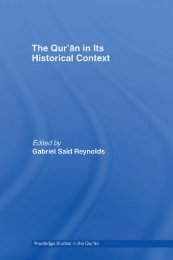Download (1 MB) - Islam and Christian-Muslim Relations: Articles ...
Download (1 MB) - Islam and Christian-Muslim Relations: Articles ...
Download (1 MB) - Islam and Christian-Muslim Relations: Articles ...
You also want an ePaper? Increase the reach of your titles
YUMPU automatically turns print PDFs into web optimized ePapers that Google loves.
INTRODUCTION 11changes in the world of the ‘ulama,<strong>and</strong> it is some of these changes—which constitute a critical part of the history of modern <strong>Islam</strong>,eventhough they have not always been adequately recognized as such—thatthis book seeks to explicate.The ‘Ulama in This StudyWith the aim of explaining the religious transformations of the ‘ulama inthe modern world,this study focuses primarily on the traditionally educated<strong>Muslim</strong> religious scholars of British India <strong>and</strong> Pakistan during thenineteenth <strong>and</strong> twentieth centuries. It examines,in particular,one highlyvisible <strong>and</strong> influential str<strong>and</strong> among the ‘ulama,viz. those belonging tothe “Deob<strong>and</strong>i” sectarian <strong>and</strong> doctrinal orientation. This orientation isassociated with a madrasa founded in a small north Indian town calledDeob<strong>and</strong> in the United Provinces (now Uttar Pradesh) in 1867. Thous<strong>and</strong>sof other madrasas—all called Deob<strong>and</strong>i,though often without anyformal affiliation with the parent madrasa—share the same doctrinal orientation,whichis emphasizes the study of law <strong>and</strong> of the traditions attributedto the Prophet Muhammad (hadith),as well as a self-consciouslyreformist ideology defined in opposition to existing forms of “popular”<strong>Muslim</strong> belief <strong>and</strong> practice. Within modern South Asian <strong>Islam</strong>,the “Deob<strong>and</strong>is”distinguish themselves not only from the Shi‘a but also from otherSunni rivals such as the “Barelawis” <strong>and</strong> the Ahl-i Hadith,both of whichalso emerged in India in the second half of the nineteenth century. Thoughthese three movements are united in their reverence for the teachings ofthe Prophet,their interpretations of the sources of religious authority differmarkedly. The Barelawis affirm the authority not just of the Prophetbut also of the saints <strong>and</strong> holy people,whom they revere as sources ofreligious guidance <strong>and</strong> vehicles of mediation between God <strong>and</strong> humanbeings. It is against such a vision of shrine <strong>and</strong> cult-based <strong>Islam</strong> that theDeob<strong>and</strong>is have preached. The Ahl-i Hadith,for their part,deny the legitimacynot just of all practices lacking a basis in scriptural texts,but evenof the classical schools of law,stringently insisting on the Qur’an <strong>and</strong>hadith as the exclusive <strong>and</strong> directly accessible sources of guidance. 56 Besidesdifferentiating themselves from each other,the Deob<strong>and</strong>is,the Barelawis,theAhl-i Hadith,<strong>and</strong> the Shi‘a are all opposed to the Ahmadis,who profess belief in Mirza Ghulam Ahmad (d. 1908) as a prophet afterMuhammad. This Ahmadi belief contravenes the doctrine that Muhammadwas the last of God’s prophets,<strong>and</strong> the Ahmadis are therefore regardedas heretical by most other <strong>Muslim</strong>s. 57All of these movements,including the Ahmadi,are products of a timeof great ferment in the history of <strong>Muslim</strong> India. How <strong>Muslim</strong> scholars



